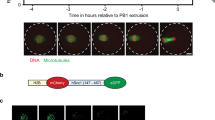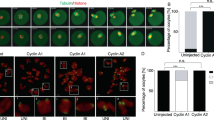Abstract
IN vertebrates, mature eggs are arrested at the second meiotic metaphase by the cytostatic factor (CSF)1, now known to be thec- mos proto-oncogene product (Mos)2, 3. Fertilization or egg activaá-tion triggers a transient increase in the cytoplasmic free calcium4, 5 and releases the meiotic arrest by inactivating maturation/mitosis-promoting factor (MPF)6, 7. CSF or Mos, which is also inactivated by the calcium transient8, 9, seems to stabilize MPF in mature eggs and CSF-injected embryos2, 6, 10. Thus, it was assumed that CSF inactivation is the primary cause of MPF inactivation on meiotic release2, 6, 8, 10–14. We have directly compared the degradation kinetics of CSF (Mos) and MPF during meiotic release, using the same batch of Xenopus eggs. We report here that, at the molecular level, cyclin subunits of MPF are degraded before Mos is degraded and, at the physiological level, that MPF activity is inactivated before CSF activity during activation of Xenopus eggs. These results, in conjunction with circumstantial evidence, support the novel view that a calcium transient on fertilization induces a CSF-independent pathway for MPF inactivation, whereas CSF inactivation during meiotic release serves only to allow the fertilá-ized egg to enter mitosis.
This is a preview of subscription content, access via your institution
Access options
Subscribe to this journal
Receive 51 print issues and online access
$199.00 per year
only $3.90 per issue
Buy this article
- Purchase on Springer Link
- Instant access to full article PDF
Prices may be subject to local taxes which are calculated during checkout
Similar content being viewed by others
References
Masui, Y. & Markert, C. L. J. exp. Zool. 177, 129–146 (1971).
Sagata, N., Watanabe, N., Vande Woude, G. F. & Ikawa, Y. Nature 342, 512–518 (1989).
Okazaki, K. et al. Jap. J. Cancer Res. 82, 250–253 (1991).
Busa, W. B. & Nuccitelli, R. J. Cell Biol. 100, 1325–1329 (1989).
Kubota, H. Y., Yoshimoto, Y., Yoneda, M. & Hiramoto, Y. Devl Biol. 119, 129–136 (1987).
Newport, J. W. & Kirschner, M. W. Cell 37, 731–742 (1984).
Murray, A. W. & Kirschner, M. W. Nature 339, 275–280 (1989).
Meyerhof, P. G. & Masui, Y. Devl Biol. 61, 214–229 (1977).
Watanabe, N., Vande Woude, G. F., Ikawa, Y. & Sagata, N. Nature 342, 505–511 (1989).
Gerhart, J., Wu, M. & Kirschner, M. J. Cell Biol. 98, 1247–1255 (1984).
Murray, A. W., Solomon, M. J. & Kirschner, M. W. Nature 339, 280–286 (1989).
Hunt, T. Nature 342, 483–484 (1989).
Roy, L. M. et al. Cell 61, 825–831 (1990).
Lorca, T. et al. Molec. cell. Biol. 11, 1171–1175 (1991).
Gautier, J. et al. Cell 60, 487–494 (1990).
Minshull, J., Golsteyn, R., Hill, C. S. & Hunt, T. EMBO J. 9, 2865–2875 (1990).
Sagata, N., Oskarsson, M., Copeland, T., Brumbaugh, J. & Vande Woude, G. F. Nature 335, 519–525 (1988).
Freeman, R. S., Kanki, J. P., Ballantyne, S. M., Pickham, K. M. & Donoghue, D. J. J. Cell Biol. 111, 533–541 (1990).
Yew, N., Oskarsson, M., Daar, I., Blair, D. G. & Vande Woude, G. F. Molec. cell. Biol. 11, 604–610 (1991).
Shibuya, E. K. & Masui, Y. Devl Biol. 129, 253–264 (1988).
Karsenti, E., Newport, J., Hubble, R. & Kirschner, M. J. Cell Biol. 98, 1730–1745 (1984).
Glotzer, M., Murray, A. W. & Kirschner, M. W. Nature 349, 132–138 (1991).
Studier, F. W. & Moffatt, B. A. J. molec. Biol. 189, 113–130 (1986).
Sagata, N., Daar, I., Oskarsson, M., Showalter, S. D. & Vande Woude, G. F. Science 245, 643–646 (1989).
Author information
Authors and Affiliations
Rights and permissions
About this article
Cite this article
Watanabe, N., Hunt, T., Ikawa, Y. et al. Independent inactivation of MPF and cytostatic factor (Mos) upon fertilization of Xenopus eggs. Nature 352, 247–248 (1991). https://doi.org/10.1038/352247a0
Received:
Accepted:
Issue Date:
DOI: https://doi.org/10.1038/352247a0
This article is cited by
-
Regulation of paternal 5mC oxidation and H3K9me2 asymmetry by ERK1/2 in mouse zygotes
Cell & Bioscience (2022)
-
A direct link of the Mos–MAPK pathway to Erp1/Emi2 in meiotic arrest of Xenopus laevis eggs
Nature (2007)
-
New insight into metaphase arrest by cytostatic factor: from establishment to release
Oncogene (2007)
-
Mammalian Emi2 mediates cytostatic arrest and transduces the signal for meiotic exit via Cdc20
The EMBO Journal (2006)
-
The Polo-like kinase Plx1 interacts with and inhibits Myt1 after fertilization of Xenopus eggs
The EMBO Journal (2005)
Comments
By submitting a comment you agree to abide by our Terms and Community Guidelines. If you find something abusive or that does not comply with our terms or guidelines please flag it as inappropriate.



